Apparatus for the study of the electro-degradation or resistive switching phenomena
Determining the equilibrium concentration of defects at high temperatures is essential in studying innovative materials’ physical and chemical properties, e.g., materials for gas sensors, heterogenous catalysis, high-temperature fuel cells, resistive switched memories, piezoelectric/ferroelectric oxides, etc. For such analysis of the type of defect, their concentration and activation energy can be determined using different physical and chemical techniques.
The most popular method of defect chemistry is based on measuring the electrical conductivity as a function of the partial pressure of different oxidizing and reducing gases. Although such investigations are essential and have a long tradition, a crucial point is controlling the gas partial pressure, such as the oxygen partial pressure. The pressure can be adjusted by conventional gas mixing (buffer gases, like CO/CO2 or H2/H2O) or electrochemically using the oxygen pump (YSZ).
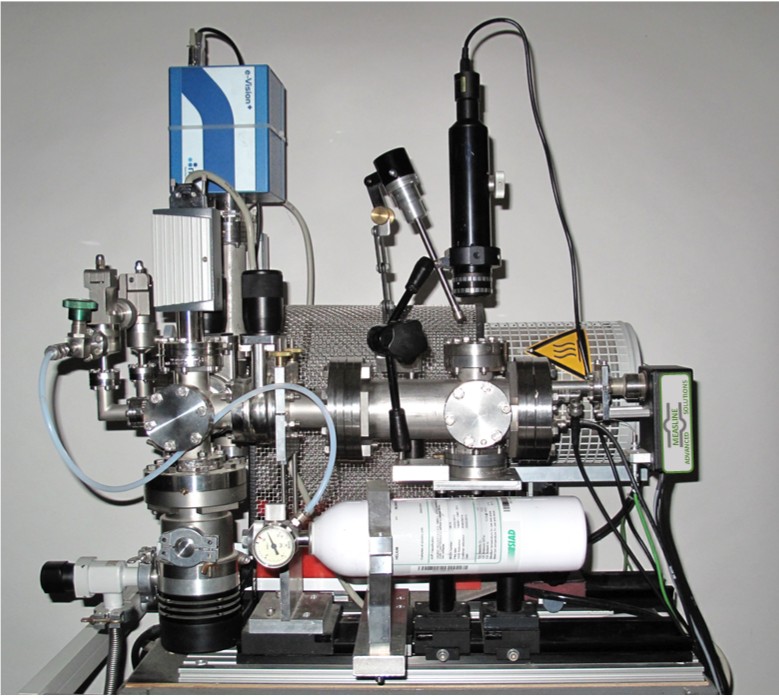
Station for studying electrodegradation processes as a function of electric field strength, temperature, and oxidant activity
The equipment enables the examination of the electro-degradation, electro-reduction, electro-deoxidation processes of crystalline and polycrystalline samples as a function of the electric field strength, temperature, and activity of oxidant (which can be achieved by controlling the partial pressure of, e.g., oxygen in the vacuum chamber). These complicated processes, which analysis is essential for understanding aging processes (e.g., nature of electrical or thermal breakdown), electrochemical degradation, or electrical switching phenomena ( so-called resistive switching), can be observed for samples with two or multielectrode configuration.
The using of multielectrode geometry allows the simultaneous analysis of the potential distribution (1-10 probes) along the sample and determines the role of the regions close to the electrodes (interfaces) and the interior of the sample in the electric transport. After degrading the sample’s resistance, the electrical conductivity’s character can be determined using the same system for the complete sample and in all its regions (between the probes) by measuring the thermal dependence of the resistance. In addition, the I/V characteristics can be measured for the iso-thermic conditions globally or in different areas of the sample.
Because the system offers the vacuum range typical for the cosmic conditions, this apparatus allows the analysis of the stability of the different materials used for space technology, e.g., piezoelectric actuator exposed to long electrical polarization.
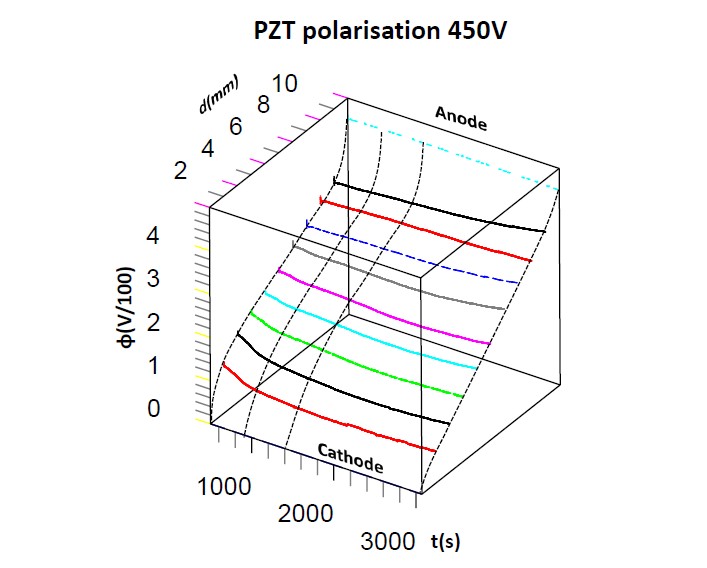
The evolution of the potential distribution at moderate temperature for model piezoelectrics ceramic ( here PZT) exposed on cosmic conditions
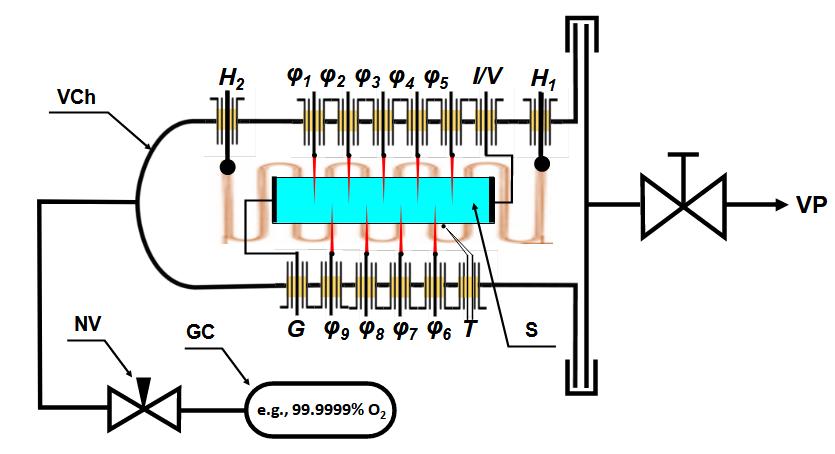
Schematic of the multi-electrodes system for determining the potential distribution along the polarized sample as a function of the electro-degradation time or the partial pressure of different gases. Legend: S-sample, G- Voltage source or generator, I/V current-to-voltage converter, φ1-φ9– potential distribution along the sample (the potential will be determined electrometrically), T-thermocouple, H-heating elements, VP vacuum pump, NV-variable leak valve.
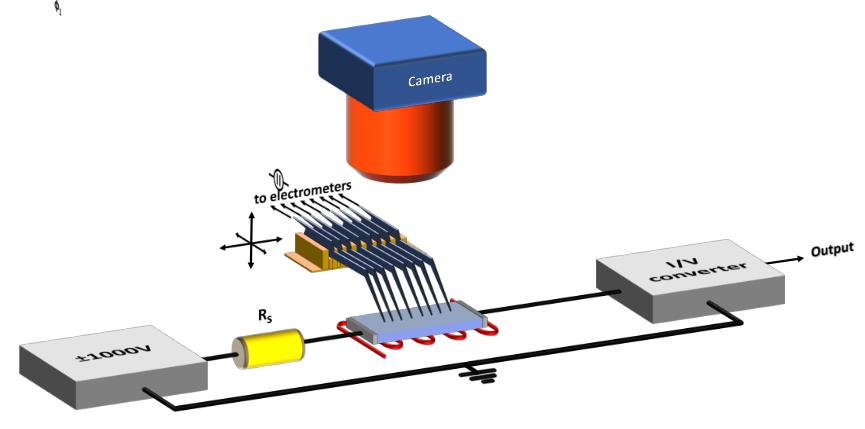
The schema of the system for the characterization of electrodegradation phenomena
Moreover, the system enables the investigation of electro-degradation processes in solid-state materials with the option to integrate an infrared camera or microscope with a long working distance (e.g., FLIR). This configuration allows for real-time temperature mapping of the sample surface, providing insight into local heating effects, current paths, and the formation of hot spots during electrical loading.
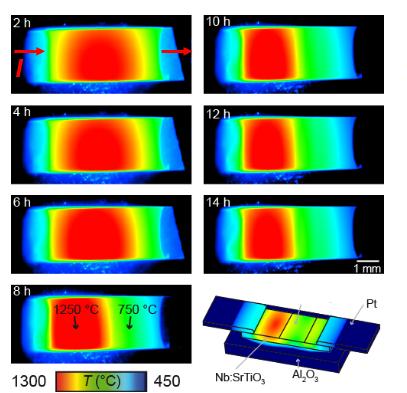
Temperature distribution along of Nb-doped SrTiO₃(100) single crystal during electrodegradation with high current density, which has induced self-heating of the crystal. Infrared images obtained in operando with X6540sc, FLIR Systems Rodenbucher et al. Scientific Reports 8:3774 (2018)
The most significant device features:
- Independent of Gas Temperature and Oxygen Pump Limitations
– Partial pressure control is not dependent on the temperature of gas mixtures or the operation of oxygen pumps
– Eliminates the need for YSZ oxygen pumps, which require ionic conductivity and cannot operate below 500 °C
– Allows experiments at lower temperatures inaccessible to traditional electrochemical control systems - Precise Control of Gas Partial Pressure
– Enables operation under XHV (extremely high vacuum) or UHV (ultra-high vacuum) conditions
– Allows accurate introduction of well-defined doses of various gases into the vacuum system -
Capability to study complex electrochemical processes:
-Electro-degradation
-Electro-reduction
-Electro-deoxidation - Degradation processes can be analyzed as a function of:
-electric field strength,
-temperature,
-oxidant activity (e.g., controlled via oxygen partial pressure in the vacuum chamber). - Suitable for investigating material aging and resistive switching phenomena
-
Two- and multi-electrode configurations:
-Allows connection of 1 to 10 electrodes/probes.
-Enables simultaneous measurement of potential distribution along the sample.
-Helps distinguish the roles of interfacial regions (near electrodes) and the bulk of the sample in charge transport. - Allows characterization of charge transport by distinguishing the contributions of interfacial regions (near the electrodes) and the bulk of the sample.
-
Characterization of electrical conductivity after degradation:
-The system allows continued measurements even after the sample’s resistance has changed.
-Enables analysis of overall and local conductivity behavior by measuring the temperature dependence of resistance between individual probes. -
Measurement of I/V characteristics can be carried out:
–under isothermal conditions,
-globally (entire sample),
-or locally (between selected electrodes).
Additional options
-
In-situ resistance measurements:
The ability to raise and lower the probes enables in-situ studies of resistance changes induced by processes such as sputtering. It also allows for transferring the sample to other UHV system modules (e.g., XPS, LEED). Samples can be mounted on standard holders, such as Omicron-compatible holders. -
Flexible probe positioning:
Probe positioning can be performed manually or automatically using an XYZ manipulator for high spatial accuracy. -
Infrared temperature mapping:
An infrared camera or microscope with a long working distance (e.g., FLIR systems) can be integrated for temperature mapping of the sample during electro-degradation studies.
Specification:
| Method (option 1) |
DC 4-point method (with triaxial shielding) |
|
Temperature |
RT-1100°C (±0.05°C ) |
| Basis vacuum |
p<5×10-10 mbar (UHV) p<1×10‾¹² mbar (XHV) |
| Gas Pressure Adjustment |
from 10‾⁹ to 10³ mbar – dynamically from the pressure higher than 10‾³–10³ -statically |
|
Determination of gas pressure |
calibrated vacuum gauge optional: the partial pressure of different gases measured using a mass spectrometer
|
|
The resistance of the sample |
should not be higher than 10¹² Ohm |
|
Measurement modes |
I-const. I (100mA- 1fA), Vvar.( ± 200V, adjustable compliance) V-const. Vmax (± 200V), I (100mA- 100fA, adjustable compliance), |
|
Type of samples |
single crystal, ceramic, powder, thin films max. dimension 1×0.5×0.3cm³ |
|
|
|
|
Method (option 2) |
DC multielectrode-system |
|
The number of probes |
can be selected from 1 to 10 |
| Probes’ configuration and geometry |
possibly adjusting the probes’ position to the sample’s geometry the probes’ head can be connected to the XYZ manipulator The Valdes or van der Pauw geometry of electrodes is possible |
|
Analysis method for slowly varying potential distribution |
can be analyzed via mobile electrode |
| Temperature |
RT-1100°C (±0.05°C) |
| Basis vacuum | p<5×10-10 mbar (UHV) |
| Gas Pressure Adjustment |
from 10‾⁹ to 10³mbar – dynamically from the pressure higher than 10‾³–10³ -statically |
|
The resistance of the sample |
should not be higher than 10¹² Ohm for a 4-electrode system should be lower than 10¹¹Ohm for system with higher number of electrodes (> 4) |
We invite you to explore the publications presenting the results achieved with the device described above:
Ch. Rodenbucher et al. APL Mater. 9, 011106 (2021)
K.Szot et al. Solid State Physics Chapter 4 Vol.65 (2014)
Rodenbucher et al. Scientific Reports 8:3774 (2018)
Explore other system configurations that offer extended functionality and broader application possibilities:
Apparatus for the study of defect chemistry of solid state
Apparatus for studies of thermally or electrochemically induced desorption processes
System for impedance spectroscopic measurements at high temperature with control of the partial pressure in chamber
We also provide systems for ceramic thin-film deposition as well as cryostats for low-temperature measurements of material properties, including ferroelectric behavior.





